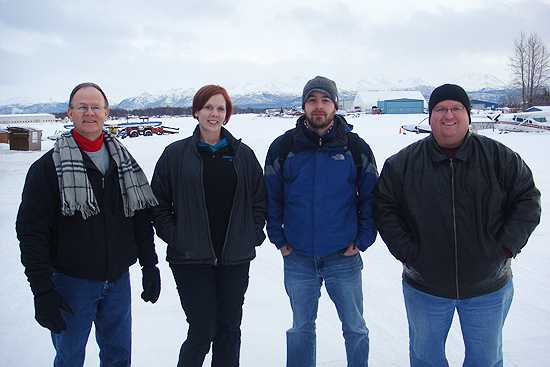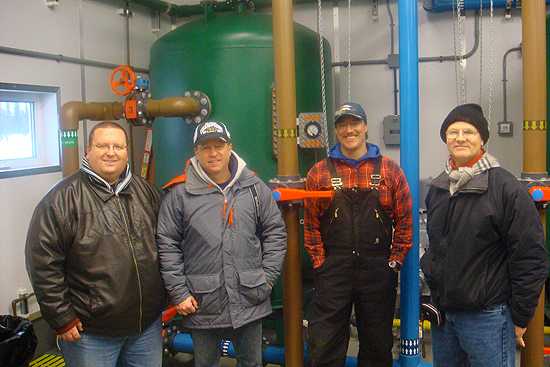EHTER Goes to Alaska
 CAPT Mark Miller, LTJG Katie Burbage (Alaska Native Tribal Health Consortium), Chris Fish (Alaska Native Tribal Health Consortium), and Martin Kalis at the EHTER Alaska course
CAPT Mark Miller, LTJG Katie Burbage (Alaska Native Tribal Health Consortium), Chris Fish (Alaska Native Tribal Health Consortium), and Martin Kalis at the EHTER Alaska courseFlying in a small plane over the Cook Inlet added a bit of adventure to a February 2011 visit to Alaska for three National Center for Environmental Health staff members. The bumpy ride to the village of Tyonek was worth the discomfort, however. The remote native village of less than 100 residents boasts a facility not often seen in rural Alaska.
The village council vice president proudly took Martin Kalis, CAPT Mark Miller, CAPT Mike Herring, and other Indian Health Service and Alaska Native Tribal Health Consortium members on a tour of their new state-of-the-art water treatment plant made possible through a grant from the U.S. Department of Agriculture and the U.S. Environmental Protection Agency. The visit also gave village leaders an opportunity to talk about some of their unsolved environmental health issues, like dump sites and open burning and gave Kalis, Miller and Herring a better appreciation of the challenges faced by this particular village and villages throughout Alaska.
Kalis, CAPT Miller, and CAPT Herring were actually in Alaska to deliver a condensed two-day version of the Environmental Health Training in Emergency Response (EHTER) course to more than 50 environmental health professionals and other emergency response partners from across Alaska, as well as experts from other federal and state agencies. Kalis says, “We were able to incorporate some of what we saw in Tyonek and our understanding of the situation into our discussions in some of the modules during the training. The visit opened our eyes to what many villages face throughout the state.”
 Environmental Health Specialists Brandon Parker (Bristol Bay Area Health Corporation, AK) and Paul Eaton (Maniilaq Association, AK) working on table exercise at EHTER Alaska course
Environmental Health Specialists Brandon Parker (Bristol Bay Area Health Corporation, AK) and Paul Eaton (Maniilaq Association, AK) working on table exercise at EHTER Alaska courseEmergencies Are Common in Alaska
According to LTJG Katie Burbage, Assistant Environmental Health Consultant with the Alaska Native Tribal Health Consortium, environmental health training is particularly needed in Alaska. “Alaska is vulnerable to a number of manmade and natural disasters. It is not a matter of if an emergency will happen, but when. And here in Alaska, even normal circumstances can prove to be logistically challenging. Planning and preparing for emergencies are imperative.” She added that the combined experiences of the course attendees added to the relevance of the course and “helped our CDC instructors learn a thing or two about Alaska!”
LTJG Burbage says that during a disaster, “Our responsibilities may include an increased need for the services we provide daily or the wearing of an entirely different hat.” CDR Bryen Bartgis, RN, a case manager for the Southcentral Foundation, agrees. “Although I am not the environmental health or engineer type and am in a completely different field, this course better prepared me for emergency deployments.”
 Martin Kalis, CAPT Mike Herring, Samuel Lee Bartels (environmental health practitioner, Tyonek, AK), and CAPT Mark Miller visiting the water treatment facility in Tyonek, AK
Martin Kalis, CAPT Mike Herring, Samuel Lee Bartels (environmental health practitioner, Tyonek, AK), and CAPT Mark Miller visiting the water treatment facility in Tyonek, AKMany of those who took the EHTER course regularly work with remote Alaska Native villages even smaller than Tyonek, so the disaster management module of the training “helped identify areas for potential involvement of those environmental professionals,” Burbage said. “I have already used what I learned to engage community partners in preparedness conversations with site-specific considerations.”
As a key sponsor and supporter of the EHTER course in Alaska, the Indian Health Service Environmental Health Support Center was so impressed that the agency has requested another course in 2012, this time for Plains Indian tribes and their state and local partners in North Dakota, South Dakota, Iowa, and other parts of the upper Midwest.
Top of Page- Page last reviewed: October 19, 2011
- Page last updated: October 19, 2011
- Content source:


 ShareCompartir
ShareCompartir